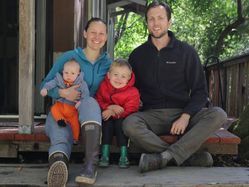|
I am a marine ecologist that works at the intersection of community and behavioral ecology. I focus on rocky intertidal ecosystems and am interested in how species interactions and communities are affected by climate change, environmental variation, and marine diseases. I study how predators affect prey populations and prey behavior, and am particularly interested in the resulting consequences of these key interactions for the rest of the players in the ecosystem.
As a Research Associate in the PISCO group (Partnership for Interdisciplinary Studies of Coastal Oceans, https://www.piscoweb.org/) at Oregon State University, I am a member of Bruce Menge and Jane Lubchenco's laboratory. I am studying the ecological consequences of sea star wasting disease for intertidal communities from Oregon to Central California. The disease struck sea star populations from Mexico to Alaska, wiping out 60-90% of Pisaster ochraceus individuals in most populations. I am using this large-scale natural experiment to determine how and when predators shape communities. This work is especially important as predators are increasingly threatened by human activities in all ecosystems. I am especially interested in the ways in which communities can be resilient or resistant to declines in these top predators, and how we can help manage systems to increase their resilience to human-related disruption. As a leading member of the Pycnopodia Recovery Working Group, I was a lead author on the listing of the sunflower sea star as an endangered species through the IUCN Red List after its severe declines from wasting disease. I am actively working to understand and restore this species. This large predator has over 20 arms and can grow to the size of an extra large pizza. It is also a top predator, and its decline was followed by a rapid increase in its herbivorous sea urchin prey and a decline in kelp forests. I am working to understand basic demographic information on this star, and to understand whether it truly can support healthy kelp forests. As a science advisor to the Oregon Kelp Alliance (https://www.oregonkelp.com/), I am working to actively restore Oregon's once lush kelp forests by working with a diverse group of researchers, commercial divers, aquaculture specialists, marine tourism businesses, restaurants, local tribes, and more. We are testing and implementing several tools to reduce sea urchin densities and support kelp recovery. Email: gravems@oregonstate.edu Office: OSU Research Way Building Room 1174 Mailing address: 4575 Research Way, Corvallis, OR 97333 |
LubMenge LabI am a member of the Bruce Menge and Jane Lubchenco laboratory at Oregon State University. We study rocky intertidal ecosystems and address problems in the global ocean. I am studying the consequences of sea star wasting disease for intertidal ecosystems.
|
Morgan Lab I received my PhD from University of California Davis in Steven Morgan's laboratory. I was stationed at Bodega Marine Lab in Sonoma County, California. I studied the domino effects that predators have on communities by scaring their prey and the effects of warming temperatures on intertidal communities
|
My FamilyWhen not out at the coast, I spend time with my family and play with my sons. Right now they like Star Wars and drooling, respectively
|
Proudly powered by Weebly





